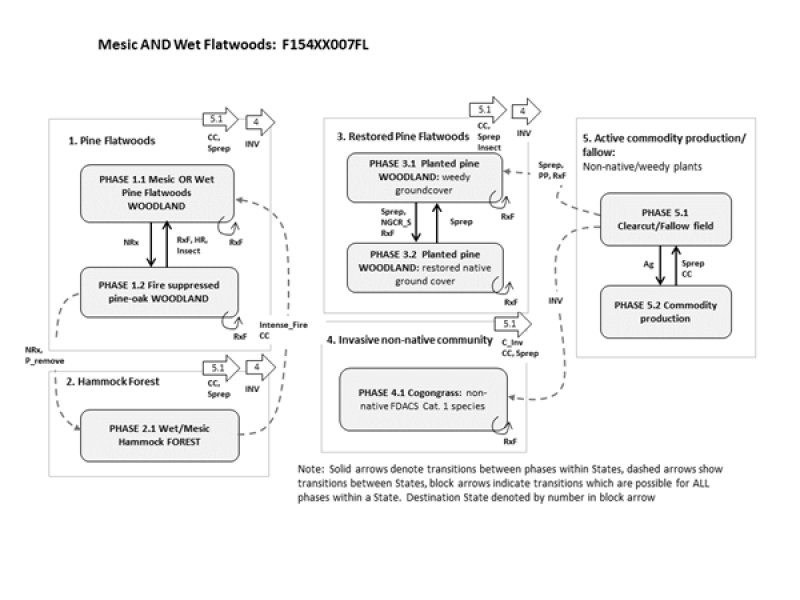
Natural Resources
Conservation Service
Ecological site F154XA007FL
Moist Sandy Wet-Mesic Flatwoods
Last updated: 2/21/2024
Accessed: 12/22/2024
General information
Provisional. A provisional ecological site description has undergone quality control and quality assurance review. It contains a working state and transition model and enough information to identify the ecological site.
MLRA notes
Major Land Resource Area (MLRA): 154X–South-Central Florida Ridge
MLRA 154 is entirely in Peninsular Florida, and contains 8,285 square miles. The landscape of MLRA 154 is characterized by a series of parallel, prominent sandy ridges of Pleistocene marine origin, including the Brooksville and Mount Dora Ridges. These North to South oriented parallel ridges are interspersed with more low lying physiographic provinces, including: upland hills, plains, valleys and gaps (Puri and Vernon 1964). The extreme western portion of the MLRA consists of thin belt of coastal lowlands and marshlands.
Many of the soils of MLRA 154 are Pleistocene or Holocene sands that are underlain with older, loamy Pliocene marine sediments (Cypresshead formation) or the clayey Miocene marine sediments (Hawthorne formation). A combination of marine depositional events and the dissolution of underlying limestone (karst geology) is responsible for surficial topography throughout Peninsular Florida.
Classification relationships
All portions of the geographical range of this site falls under the following ecological / land classifications including:
-Environmental Protection Agency’s Level 3 and 4 Ecoregions of Florida: 75 Southern Coastal Plain; 75c Central Florida Ridges and Uplands (Griffith, G. E., Omernik, J. M., & Pierson, S. M., 2013)
-Florida Natural Area Inventory, 2010 Edition: Mesic Flatwoods, Wet Flatwoods, Mesic Hammock, and Hydric Hammock (FNAI, 2010)
Ecological site concept
Moist Sandy Wet-Mesic Flatwoods occur on very deep, poorly drained and nearly level soils that have a sandy or sandy over loamy subsoil. In general, the soils are moist sands with or without spodic horizons. Soil series include very deep, poorly drained, sands (Basinger, Immokalee, Myakka, Ona, Placid, Pompano, Pottsburg, Smyrna, St. Johns), and the sands over loamy soil (Delks, EauGallie, Ft. Green, Holopaw, Lynne, Malabar, Oldsmar, Palmetto, Plummer, Pomona, Riviera, Sapelo, Wabasso, Wauberg, Wauchula, Winder). This concept is predominantly mapped in the Central Valley, Gulf Coastal Lowlands, St. Johns River Offset, Tsala Apopka Plain, and Western Valley physiographic units, and to a lesser extent in the Duval Uplands, Marion Uplands, and the Northern Highlands.
Associated sites
| F154XA005FL |
Poorly Drained Upland Pine-Hardwood Forests These are poorly drained sites on upland flats rather than lowland flats, resulting in slightly drier natural vegetative communities |
|---|---|
| F154XA010FL |
Moist Lithic Flatwoods And Hammocks These are somewhat poorly drained sites that have a water table deeper than 30 cm and lithic contact within 152 cm |
| F154XA011FL |
Wet Lithic Flatwoods And Hammocks These are poorly drained sites on similar landforms that will have lithic contact within 40 inches of the soil surface |
| F154XA012FL |
Wet Rich Forests And Woodlands These are poorly drained sites on similar landforms that will have a higher subsoil clay percentage |
| F154XA014FL |
Histic Wetland Depressions These are very poorly drained organic soils that pond frequently and will support wetland habitats |
| F154XA015FL |
Mineral Depressional Wetlands These are very poorly drained mineral soils that pond frequently and will support wetland habitats |
Similar sites
| F154XA005FL |
Poorly Drained Upland Pine-Hardwood Forests These sites will have similar drainage on slightly higher landscape positions, resulting in different types of vegetation and management strategies |
|---|---|
| F154XA008FL |
Moist Sandy Scrubby Flatwoods These sites will have slightly better drainage (depth to seasonal high water table >30 to 91 cm) and will occur on similar soils, resulting in a drier species composition |
| F154XA012FL |
Wet Rich Forests And Woodlands These sites will have similar soil drainage and landscape positions, but will have a higher percentage of subsoil clay (greater than 10%) which will influence species composition and production |
Table 1. Dominant plant species
| Tree |
(1) Pinus palustris |
|---|---|
| Shrub |
(1) Serenoa repens |
| Herbaceous |
(1) Aristida stricta |
Click on box and path labels to scroll to the respective text.


